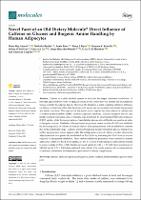Please use this identifier to cite or link to this item:
https://repositorio.usj.es/handle/123456789/605
| Title: | Novel facet of an old dietary molecule? Direct influence of caffeine on glucose and biogenic amine handling by human adipocytes |
| Authors: | Ahmed W.H.


Boulet, Nathalie 

Briot, Anaïs 

Ryan B.J. 

Kinsella, Gemma K. 

O’sullivan, Jeffrey 
Les Parellada, Francisco 

Mercader-Barceló, Josep 
Henehan, Gary T. M. 

Carpéné, Christian 

|
| Keywords: | Caffeine; Adipocyte; Lipolysis; Lipogenesis; Amine oxidases; Methylxanthines; Glucose transport |
| Issue Date: | 23-Jun-2021 |
| Publisher: | MDPI AG |
| Citation: | Ahmed, W.H.; Boulet, N.; Briot, A.; Ryan, B.J.; Kinsella, G.K.; O’Sullivan, J.; Les, F.; Mercader-Barceló, J.; Henehan, G.T.M.; Carpéné, C. Novel Facet of an Old Dietary Molecule? Direct Influence of Caffeine on Glucose and Biogenic Amine Handling by Human Adipocytes. Molecules 2021, 26, 3831. https://doi.org/10.3390/molecules26133831 |
| Abstract: | Caffeine is a plant alkaloid present in food and beverages consumed worldwide. It has high lipid solubility with recognized actions in the central nervous system and in peripheral tissues, notably the adipose depots. However, the literature is scant regarding caffeine’s influence on adipocyte functions other than lipolysis, such as glucose incorporation into lipids (lipogenesis) and amine oxidation. The objective of this study was to explore the direct effects of caffeine and of isobutylmethylxanthine (IBMX) on these adipocyte functions. Glucose transport into fat cells freshly isolated from mice, rats, or humans was monitored by determining [3H]-2-deoxyglucose (2-DG) uptake, while the incorporation of radiolabeled glucose into cell lipids was used as an index of lipogenic activity. Oxidation of benzylamine by primary amine oxidase (PrAO) was inhibited by increasing doses of caffeine in human adipose tissue preparations with an inhibition constant (Ki) in the millimolar range. Caffeine inhibited basal and insulin-stimulated glucose transport as well as lipogenesis in rodent adipose cells. The antilipogenic action of caffeine was also observed in adipocytes from mice genetically invalidated for PrAO activity, indicating that PrAO activity was not required for lipogenesis inhibition. These caffeine inhibitory properties were extended to human adipocytes: relative to basal 2-DG uptake, set at 1.0 ± 0.2 for 6 individuals, 0.1 mM caffeine tended to reduce uptake to 0.83 ± 0.08. Insulin increased uptake by 3.86 ± 1.11 fold when tested alone at 100 nM, and by 3.21 ± 0.80 when combined with caffeine. Our results reinforce the recommendation of caffeine’s potential in the treatment or prevention of obesity complications. |
| URI: | https://repositorio.usj.es/handle/123456789/605 |
| ISSN: | 1420-3049 |
| Appears in Collections: | Artículos de revistas |
Files in This Item:
| File | Description | Size | Format | |
|---|---|---|---|---|
| Novel Facet of an Old Dietary Molecule.pdf | 2,64 MB | Adobe PDF |  View/Open |
This item is licensed under a Creative Commons License

